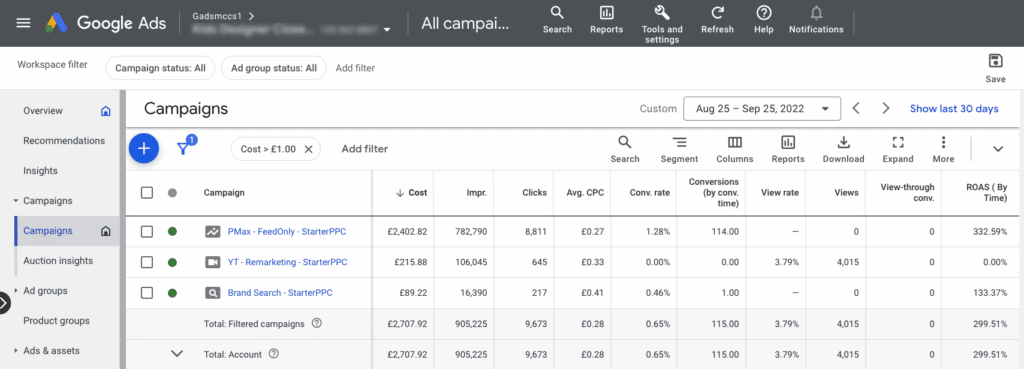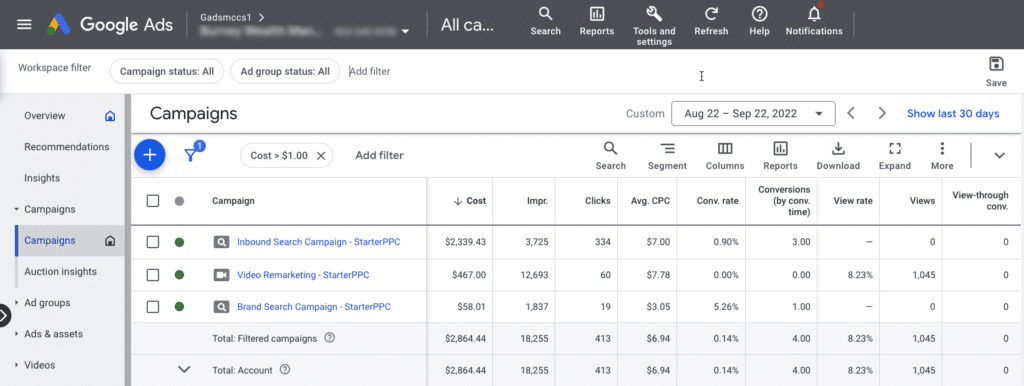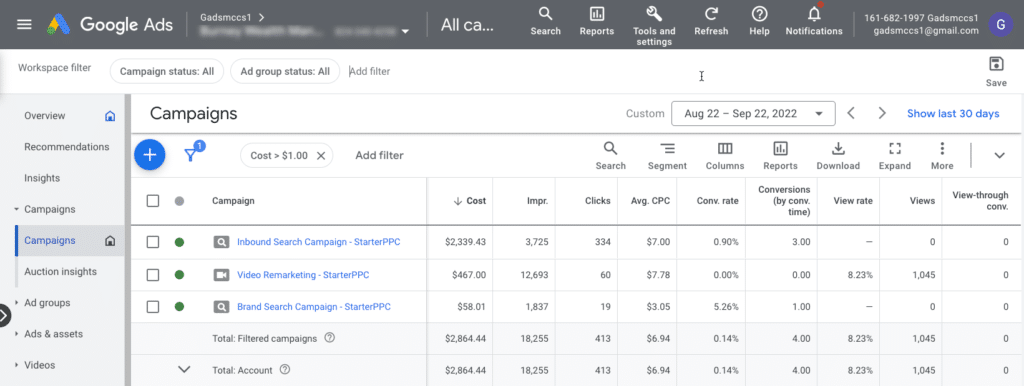Solutions 8 came up with a very good solution when looking to answer this question: ask Regina Bellows, of course! Director of STARTER PPC, our sister agency, Regina had some great pointers for some of our smaller clients looking to make the most of advertising on a limited budget.
Let’s consider what the average small business owner wants to tentatively spend on a marketing campaign. Many clients do not wish to commit to a large budget.
They give themselves a smaller amount to work with and this is where we step in. What happens when we look at clients who are working within a maximum budget of $5,000?
There are many factors to be taken into account when getting started with Google Ads.
Firstly, it will inevitably vary from business to business, and from industry to industry. Secondly, we are searching for data points, otherwise known as conversion data. This allows the algorithm to identify patterns within the campaign.
It takes us through a learning phase, the initial time period where Google gathers all the data you’ll need to successfully optimize your campaign and position it to scale.
This is the ultimate goal. But it’s not always an easy one to reach.
Let’s say, a company gets 30 conversions in its first month. That’s an average of a conversion a day. Well, the algorithm now has a significant body of data to analyze and tweak.
It can see who is buying, and in the next month will have already gone through its learning phase, which is enough to grow, or make small optimizations and then grow.
And what happens when a company only gets four conversions in a month?
If they are high-quality conversions, then data is of high quality. Even then, it might not be enough.
Four data points aren’t substantial for the algorithm to understand what to do next. Six months may have gone by before the body of data is weighty enough for the algorithm to best optimize the bidding.to guess
When data gets too old, or too few data points are gathered, things change over time before it can truly understand the patterns crucial to optimization. Some of these changes can include:
- a change of season
- new competitors on the scene
- market elements shifting
- user base has already bought and disappeared from the data pool
So, where does it leave us when the algorithm can no longer rely on old data?
“Well,” says Regina, “sometimes the budget is so small that the learning phase just never happens. And that is where it turns into a bit of a guessing game.”
Understanding how the algorithm thinks allows us an estimated guess as to what that minimum might be.
“Let’s say that the average sale for a company that sells furniture is about $800. If your budget is only $500 and you want to make a 3X return, you might need to spend a few hundred dollars on every single conversion.
A budget of $500 will only get you two conversions. That’s not enough. Meanwhile, if you were selling clothes with an average order value of $70–$80, you can get at least 30 conversions a month.”
Essentially, it boils down to this:
The higher the budget, the faster it’s going to take off!
Finding that minimum will be a judgment call. There are some good foundations to help us do that. Conversion history in an account can help, especially if it’s recent history.
Take a look at some of these examples.

This account client spent $2,700 in the first thirty days and got 115 conversions, which, for a clothing brand, is about right. The budget is good enough for the algorithm to get through the learning phase.

This next account sells jewelry. With a budget of $3,500 a month, they got 101 conversions which is also good.

This next one is a bit tricky. It’s a wealth management firm and they started with a budget of $2,800. In the first month, they only got 4 conversions. In addition, since this is a lead generation account, not all of these leads are of high quality.
Getting a lead generation account up and running means honing keywords and getting the algorithm pointed in the right direction.
In this case, three of the leads were actually low-quality spam leads and the low data point meant poor performance. Advice to a client like this is:
You need to double the ad spend!

This next client is a dropshipping furniture brand, and they spent $3,800 in the first month and got 20 conversions for their efforts, which isn’t bad at all. The client had quite a lot of conversion history which allowed the algorithm to do its job, meaning there were lots of optimizations.
Regina says:
“Clients come to us all the time, asking what’s the minimum spend. As the example above shows, this furniture company did alright thanks to its conversion history. The previous furniture business, the one with the average sale of $800, did not do so well.”
We can deduce, there are lots of factors to consider when estimating the minimum amount for a budget for Google Ads.
At 15 conversions a month, in Regina’s experience, that would be an acceptable figure to aim for. If the budget is too low and cannot guarantee this number, then she would not want to waste time wondering if optimization will ever take off. And so, good quality conversion history could be the key to finding a successful minimum budget.
Is the tracking set up correctly?
Take a look at this little gem of advice from our very own CEO Kasim Aslam on how to track conversions.
“Want a quick tip on how to succeed with Google Ads? 80% tracking and 20% optimization.
That’s obviously very simple, but it’s true. Just track user behavior and gather data. Then, adjust your strategy based on that data.
But what if you have inaccurate data? Well, you can’t optimize. Otherwise, you’re teaching Google to bring you more of those leads you don’t want.
The problem is most businesses need to learn how to track conversions correctly. Without accurate conversion tracking, it’s hard to connect the dots between your campaigns and your revenue.
By understanding what conversions are being counted, how they’re being counted, and what source they’re coming from, you’ll be able to see the whole picture clearly.
You’ll start to see valuable insights and patterns into the behavior of users who interact with your ads and get all the information you need to make informed decisions that will optimize your ads’ performance.
In other words, conversion tracking is one of the most important things you must do first.
Tracking conversions that are valuable to your business sets the foundations for how to best optimize your campaigns. Skipping this first step is setting yourself up for failure—and we want you to succeed!”
And this is where we leave you! We hope this has given you a good basis for minimum ad spend.
Author
Jani is a copywriter at Solutions 8 with a passion for short stories, dancing under the stars, and 80s pop music. Her soul’s purpose is to turn herself into a masterpiece. Her future is filled with green fields, flowers, sunshine, and poetry.
 Jani Kahukiwa
Jani Kahukiwa










